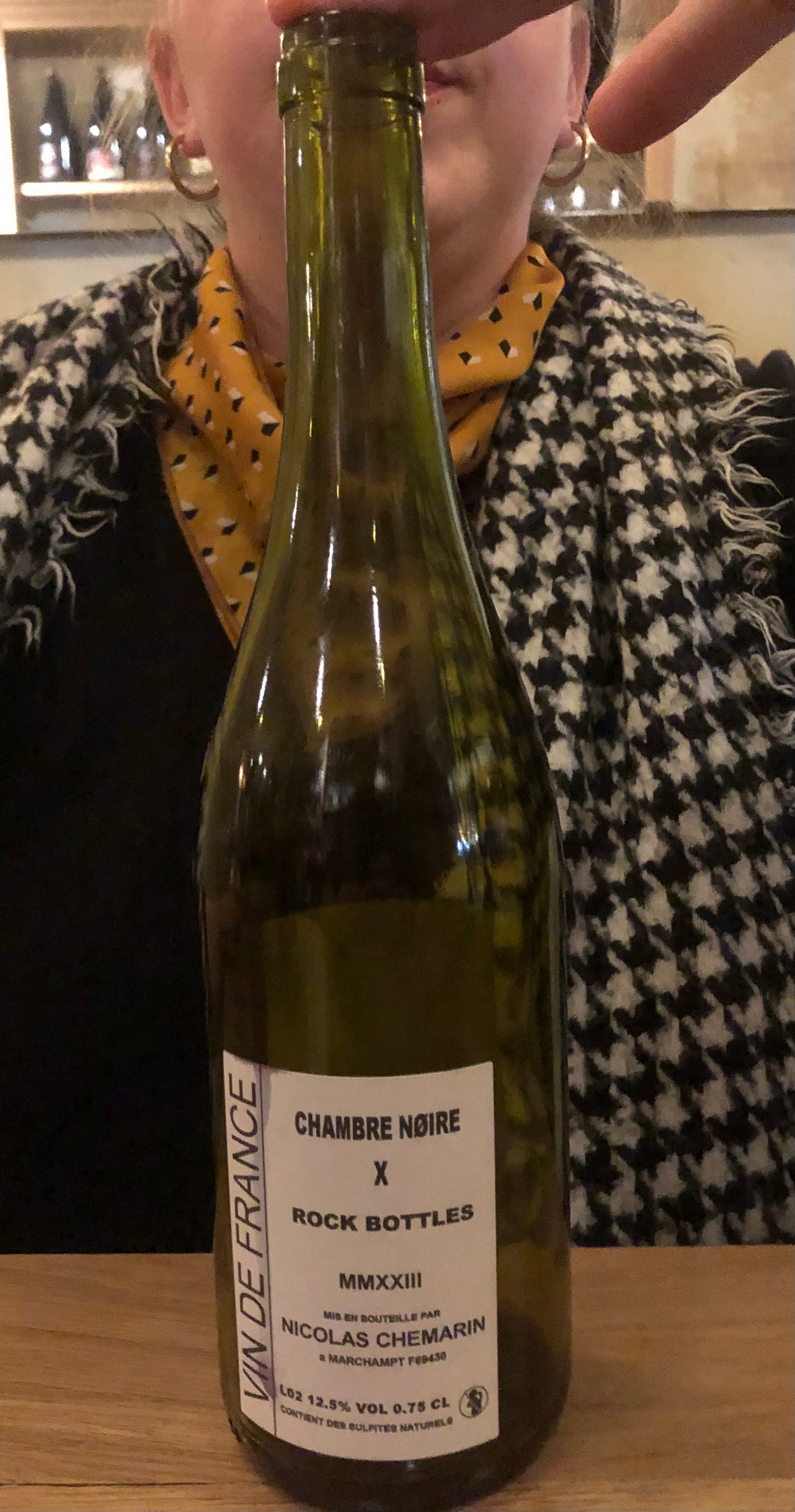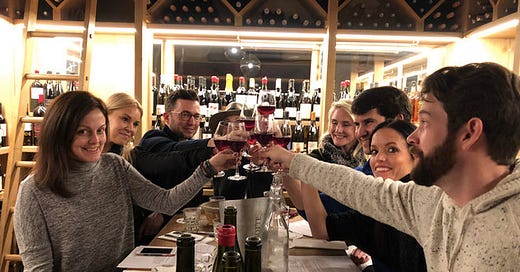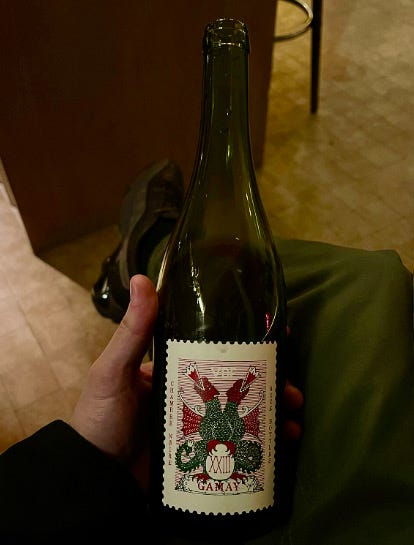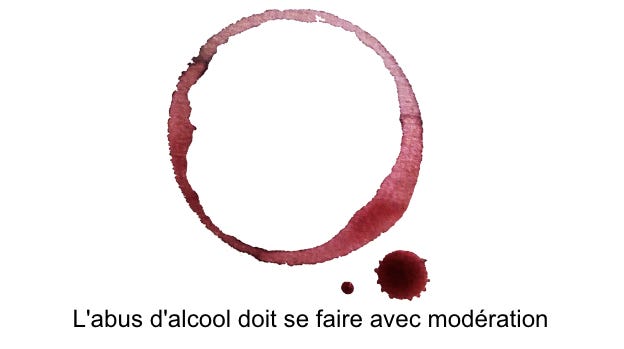Mooney here, subbing in for my, in the French sense, patron — “Le boss” Geoffrey Finch — who is too busy wine tasting this week to put down his glass for a few seconds and write a word or two about Paris, its wines, and its walks.
And its cycling tours:
Geoffrey will weigh in next week, promise. He’ll tell you then how the history of Paris is the history of wine, how for centuries it was the world’s biggest vignoble, and how it once produced the most mouth-watering wines known to man, woman, and every god and goddess in the Roman and Gaulish pantheons.
And you will be fascinated.
But the week after that Geoffrey’s new book, The Hidden Vineyards of Paris goes to print and the Christmas season hits, so he’ll be off doing book signings, wine walks, bubbly tastings, blind wine tastings, cheese and wine pairings, end-of-year office parties, wine and gastronomy tours of Champagne, the Rhone, the Loire, Bordeaux, Burgundy, and Beaujolais, and Bacchus know what else.
Which means I’ll probably have to once more unto the breach, dear friends, once more.
In the meantime…
Today is the fourth Thursday of November, which, yes, means that it is American Thanksgiving, but it also means that last Thursday was the third Thursday of November. Which, in the world of wine, means only one thing: Beaujolais Nouveau.
In previous decades, this annual event meant, pretty much without exception, a night of insipid, mass-produced, over-commercialized, banana-flavored, chaptalized nastiness, followed by the year’s worst hangover.

All that has changed. Now the arrival of Beaujolais Nouveau means — or at least can mean — delicious little Gamay wines made by some of the best natural wine makers in the world.
This year, to keep it simple, we avoided the Beaujolais Nouveau Death March and went to two spots only, both favorites and both short stumbles from home. The first was our local, La Cave à Michel on rue Sainte Marthe in the 10th, where the “bojo novo” wines by Rémi Dufaitre and Jean-Francois Debourg were exceptional. As was the food, Maxime Tischenko’s perfect oeufs mayo, padrones, and Saint Vaast oysters, and a proper boeuf bourguignon aux petits oignons confected by Allan Gillery, the 2023 “Sauce Frites” Champion at the French Fries World Championships in Arras.
Next up was our brand-new favorite, La Cave Canaille on Jean-Pierre Timbaud in the 11th, which opened its doors for the first time just minutes before our arrival. As it is the latest outpost of Oliver Lomeli’s ever-expanding Chambre Noire empire of natural wine venues in Paris — it is owned by Antony Robine, who ran the Chambre Noire on Jules Ferry and before that worked at the one on St Maur (now Les Œillets, owned by another Chambre Noire alum Maxime Dardeau) — it was already jam-packed.
The bojo primeur being poured was Nicolas Chemarin's from the Côteaux de Marchampt in Beaujolais-Villages.

And it was out-of-this-world delicious. Juicy, fresh, clean, spicy, plush, mouth-filling, fruity, stony, with notes of… a hint of… and…?
As usual, when I try to describe how wine tastes, the words fall flat. To paraphrase Elvis Costello, talking about wine, for me at least, is like writing about music and dancing about architecture. I’d rather just take another sip and keep it to myself.
Thankfully, wine words rarely fail Geoffrey, as you’ll learn in future posts. Nor do they seem to ever fail Chambre Noire’s Oliver Lomeli, as evidenced by this great podcast interview with him last month on Aaron Ayscough’s indispensable Substack:
Back to the Bojo.
We left La Cave Canaille before the food hit — pasta by Riccardo Ferrante of Jones — but not before adding a bottle to the two we’d picked up at La Cave à Michel. Then we headed to Geoffrey’s for dinner, where, over a delicious plate of I forget what exactly, he regaled us with the history of the Gamay grape and its importance in Paris and in…
The Natural Wine Movement
which started in Beaujolais in the 1930s with back-to-the-earth viticultural prophet Jules Chauvet, continued with his right-hand man Jacques Neauport, and then leapt to the fore in the early 1980s with their disciples, Kermit Lynch's “Gang of Four”: Jean Foillard, Charly Thevenet, Marcel Lapierre, and Guy Breton.
Today, their “natural” methods have taken a foothold strong enough to challenge conventional winemaking the world over.
(BTW: We’ll be doing private tastings with Marcel Lapierre and Guy Breton on their domains in Beaujolais in April, as part of a week-long Burgundy to Beaujolais trip. We’ll also be doing domain tastings in Chablis, Gevrey-Chambertin, Meursault, Monthelie, Vosne-Romanée, Santenay… Cruzille, Morgon, Fleurie, Bagnols… a dazzling lineup of face-to-face and glass-to-glass encounters with wine legends, nicely peppered with great lunches and dinners in the regions’ best bistros and restaurants, and nights in l’Hôtel de Beaune and the Château de Bagnols. If you’re interested, leave a comment or contact us here.)
Why “natural”?
No chemicals in the vineyard, no additives in the wine making, fermentation with indigenous yeasts, and little or no sulfur. Filtration and fining are often forsaken as well.
The simplest definition: “nothing added, nothing taken away”.
Geoffrey: “Just grapes, nothing else. These wines can be the most sublime expressions of terroir. Sometimes, yes, they can be a bit ‘funky’, with barnyard smells and high levels of volatile acidity, but when they’re crafted by true masters, they have amazing purity and depth, beguiling aromas, and a harmony of tastes that open slowly and rise to spectacular peaks.
“And Paris has become the mecca for these wines. Though you can still find no shortage of undrinkable plonk in the city’s crappier ‘bars à vins’ and cafés, happily, it’s being replaced almost everywhere by an astonishing range of living wines from living soils.
“We live in wine heaven — more than 700 million bottles of wine are opened in Paris each year — and more and more of them each year are truly, truly amazing.”
Gamay’s roots run especially deep in Paris
Gamay was one of the principal grapes used in Piccolo, an early plonk made in the Paris region. Piccolo was also known as Cramponne-toi-au-bord-de-la-table — “Hold-on-tight-to-the-edge-of-the-table”. I wrote about this in a post on my own Substack, Hexagon, which has a connected podcast in which Geoffrey speaks with Guillaume d’Angerville, one of Burgundy’s most reputed winemakers, who, with restaurateur Yannick Alléno and farmer-to-the-stars Laurent Berrurier, has planted 1.5 hectares of vines 30km outside of Paris.
Gamay is best known as the variety of Beaujolais and the Loire Valley. Good wines are also made from it in Switzerland, Oregon, California, and the Niagara Valley.
In Burgundy, Gamay blended with 1/3 Pinot Noir and fermented together produces Passetoutgrains, a deliciously juicy little red.
It is also used throughout France for non-appellation wines, and for many of the new IGP wines — “Indication géographique protégée” (Protected Geographical Indication) made around Paris.
For centuries, the Gamays in the Paris suburb of Suresnes were appreciated as much as the great Burgundies. The area’s vines go back to ancient times but were all but abandoned in the 19th century. It wasn’t until the 1980s that serious wines began to re-appear. Today, there are 5,000 vines. We’ll be tasting some of these wines with you in the new year.
The famous vineyard of Montmartre, which is part of our Clos Montmartre - Paris in Your Glass tour, is 70% Gamay, 10% Pinot Noir and 20% of the original varieties (Landau, Sauvignon, Chasselas, Seyve-Villard…).
A third of the 250 vines in Jardin des Plantes, the first stop on our Latin Quarter Unbottled walk, are Gamay. The other thirds are Chardonnay and Pinot Noir, as these three were traditionally the most planted in the Ile de France. The 440 vines in the municipal vineyard on the Rue de la Resistance in Cheville are half Gamay and half Pinot Noir. Gamay is also used in Clamart to produce a perfectly quaffable rosé. We’ll get to taste these too, along with wines from Parc du Sausset in Aulnay-sous-Bois (Seine-Saint-Denis), the award-winning wines of Montguichet in Chelles (Seine-et-Marne) and others from Saint Prix, Grand Morin, Melz-sur-Seine, Épinay-sur-Seine, and Saint-Fargeau-Ponthierry.
Finally, Paris’ smallest vineyard, the Clos Julienas, next to the Church of Saint-Germain-des-Prés in the 6th Arrondissement of Paris, has only ten vines in it — all Gamay from the Beaujolais village of Julienas. It’s on our Saint-Germain-des-Prés Walk and our Three Vineyard Cycling Tour.
The vineyards of the Abbaye Saint-Germain-des-Prés once produced around three million liters of wine per year. The abbey’s monks apparently consumed three liters a day each — at least, that was their dally allotment. The rest they sold.
Geoffrey: “Add to this the equally staggering output of the nearby Abbeys of Saint Denis and Notre Dame and you can see why wine was the principal product for Paris trade and the economic driver of the Middle Ages. The visible wealth this generated was mind-boggling, creating not just churches and cathedrals — almost all Gothic architecture is linked to the wine trade — but jealousies, eventually causing insurrection, and culminating in the French Revolution.
“And urban expansion and blight. As the prosperity generated through the sale of these wines grew, so did urbanization, gradually replacing vineyards with factories, plaster works, gypsum quarries, iron foundries, houses and buildings. The wines of Paris were victims of their own success. The vignobles were ripped up and the vignerons found new trades or had to go elsewhere.
“Fortunately, however, the vines are coming back in force, and winemaking in the Paris region is experiencing a new renaissance.”
But let’s save all that for another post. Or two. Or three. With Geoffrey at the helm.
Thanks for reading. We’re really glad you’re here and we look forward to your comments, and to seeing you on upcoming walks and at tastings. Go to our home page on the Substack app or on a browser or to our website to see what’s coming up.
If you don’t find an event that fits your schedule or group size, drop us a line and we’ll put together something special. Burgundy to Beaujolais, for example…
Below is a sample of upcoming events:
Sparkling Wine Splash
Immerse yourself in the effervescence of the season with our Sparkling Wine Splash experience. Whether you're celebrating a special occasion or just toasting to the joy of the holidays, our blind wine tasting of carefully selected sparkling wines invites friendly competition to see who can identify the Champagne among five fabulous sparkling wines. Book now!
Wine & Cheese Please
Indulge in classic and surprising pairings of wine and cheese with our in-depth Wine & Cheese Please tasting. Explore the nuances of flavor as our knowledgeable guides lead you through a ‘cultural’ tour de France, revealing the secrets of perfectly paired combinations. It's an ideal way to savor the sophistication of Parisian life. Book now!
Wine Walks!
For more information, click on the underlined links:
Clos Montmartre - Paris in Your Glass
Paris' most famous wine producing vineyard
Latin Quarter Unbottled!
An insider's journey to the oldest wine neighborhood in the city
Wine Your Way Through the Marais
The Marais seen through a wineglass
Saint-Germain-des-Prés
Discover the vinous spirit of medieval Paris
3-Vineyard Cycling Tour
A comprehensive overview of medieval Paris
Paris Bottled!
Short on time? This one’s for you.
















Oh dear Bacchus. We miss you and C and Geoffrey and your beautiful city. Please come for dinner at our large table when you get here. I’ve been busy hoarding bottles of the good stuff.
I am very late in commenting positively, on this charming little post, with its tantalizing imagery. In short, I want to be there partaking in this splendour.